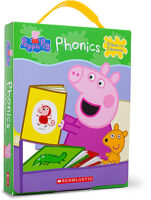Cara Foley, parent of an 11-year-old and a 16-year-old, says it’s essential to stash books wherever your child goes — in the house, in the car, in their backpack — and to make sure you as a parent carry one too, to set an example.
“I always leave the house with a book, just in case I might need one, and I encourage them to do the same — especially when we have doctor’s appointments,” Foley says.
Younger children who can’t read independently yet, don't need to be left out. They can still flip through vivid picture books and pick up context clues from the text around them – whether it's on the side of a cereal box at breakfast or on road signs on the way to school.
You are your child’s best role model. When they see you reading, they are more likely to do so themselves. Whether your go-to is a newspaper or novel, plan to read in the same room as your child — and read to each other!
“My husband and I are big readers, and the kids are very much influenced by that,” says Amanda Henry-Godino, parent to two boys ages 9 and 10. “It’s not unusual for my husband and I to be reading during the day, and the kids see that. It’s awakened them a little bit to acknowledge that you can put your phone down and spend a Sunday morning reading a book.”
Foley says she limits device usage in her household to help her daughters stick to their reading routines, specifically at night. This can help children wind down and become immersed in the worlds that books deliver. Before long, you’ll find them asking to stay up a little longer to read.
Enhancing the reading experience beyond the page can help your child connect with their favorite book in a new way. Significantly, these activities can also help gauge their reading comprehension.
“Drawing pictures based on book characters and story lines is popular with my kids for ‘continuing the magic,’” says Laura Banfield, parent of a 3-year-old and 6-year-old.
Courtney Rochowicz, a parent of a 7-year-old, 5-year-old and 3-year-old, has even recreated scenes from one of her children’s favorite books to make deeper connections to the text — in this case, Magic Tree House #4: Pirates Past Noon.
“We built an imaginary pirate ship to take the reading experience a step further, to a different creative place,” Rochowicz says.
Keep in mind that book series with movie tie-ins, like Dog Man or The Bad Guys, can be a huge draw for lovers of visual content.
When you are together, start a dialogue about what your child is reading, including what they like about the book’s plot and its characters, and what they think will happen next.
This not only helps inform you of their current interests, but also encourages your child to articulate their opinions and challenge their reading comprehension, like summarizing a plot and remembering chronologies of events.
Talking with your child also makes them feel good, and gives you the chance to build upon their excitement with an eye to future reads.
“I generally ask my children what they like about the book that they are currently reading and enjoying,” says Kimberly Greacen, a parent of a 4-year-old and 8-year-old. “Knowing what they like about it — for example, the adventure or fantasy of it — is helpful in choosing new books for them.”
Shop best-selling reads for your book lover below! You can find all books and activities at The Scholastic Store.






















